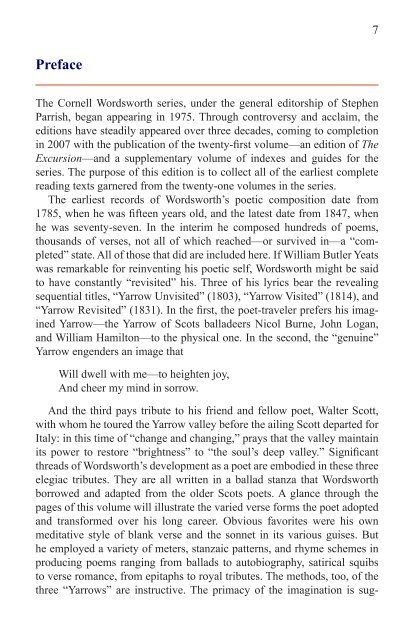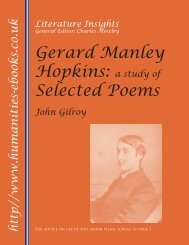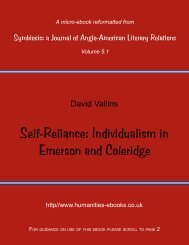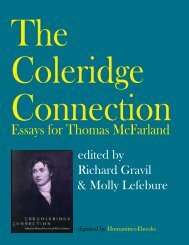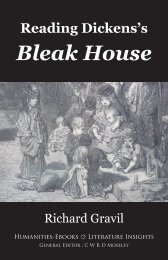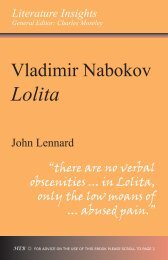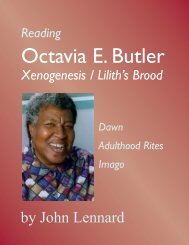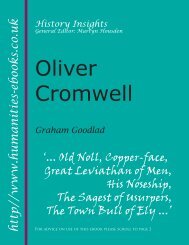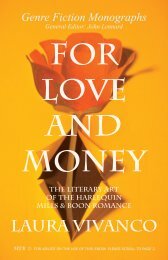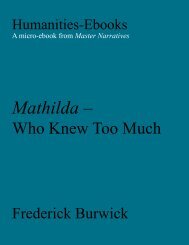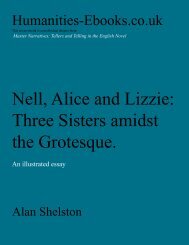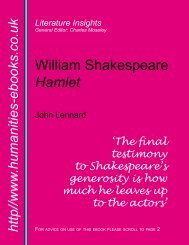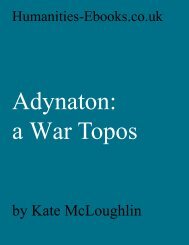The Poems of William Wordsworth - Humanities-Ebooks
The Poems of William Wordsworth - Humanities-Ebooks
The Poems of William Wordsworth - Humanities-Ebooks
You also want an ePaper? Increase the reach of your titles
YUMPU automatically turns print PDFs into web optimized ePapers that Google loves.
Preface<br />
<strong>The</strong> Cornell <strong>Wordsworth</strong> series, under the general editorship <strong>of</strong> Stephen<br />
Parrish, began appearing in 1975. Through controversy and acclaim, the<br />
editions have steadily appeared over three decades, coming to completion<br />
in 2007 with the publication <strong>of</strong> the twenty-first volume—an edition <strong>of</strong> <strong>The</strong><br />
Excursion—and a supplementary volume <strong>of</strong> indexes and guides for the<br />
series. <strong>The</strong> purpose <strong>of</strong> this edition is to collect all <strong>of</strong> the earliest complete<br />
reading texts garnered from the twenty-one volumes in the series.<br />
<strong>The</strong> earliest records <strong>of</strong> <strong>Wordsworth</strong>’s poetic composition date from<br />
1785, when he was fifteen years old, and the latest date from 1847, when<br />
he was seventy-seven. In the interim he composed hundreds <strong>of</strong> poems,<br />
thousands <strong>of</strong> verses, not all <strong>of</strong> which reached—or survived in—a “completed”<br />
state. All <strong>of</strong> those that did are included here. If <strong>William</strong> Butler Yeats<br />
was remarkable for reinventing his poetic self, <strong>Wordsworth</strong> might be said<br />
to have constantly “revisited” his. Three <strong>of</strong> his lyrics bear the revealing<br />
sequential titles, “Yarrow Unvisited” (1803), “Yarrow Visited” (1814), and<br />
“Yarrow Revisited” (1831). In the first, the poet-traveler prefers his imagined<br />
Yarrow—the Yarrow <strong>of</strong> Scots balladeers Nicol Burne, John Logan,<br />
and <strong>William</strong> Hamilton—to the physical one. In the second, the “genuine”<br />
Yarrow engenders an image that<br />
Will dwell with me—to heighten joy,<br />
And cheer my mind in sorrow.<br />
And the third pays tribute to his friend and fellow poet, Walter Scott,<br />
with whom he toured the Yarrow valley before the ailing Scott departed for<br />
Italy: in this time <strong>of</strong> “change and changing,” prays that the valley maintain<br />
its power to restore “brightness” to “the soul’s deep valley.” Significant<br />
threads <strong>of</strong> <strong>Wordsworth</strong>’s development as a poet are embodied in these three<br />
elegiac tributes. <strong>The</strong>y are all written in a ballad stanza that <strong>Wordsworth</strong><br />
borrowed and adapted from the older Scots poets. A glance through the<br />
pages <strong>of</strong> this volume will illustrate the varied verse forms the poet adopted<br />
and transformed over his long career. Obvious favorites were his own<br />
meditative style <strong>of</strong> blank verse and the sonnet in its various guises. But<br />
he employed a variety <strong>of</strong> meters, stanzaic patterns, and rhyme schemes in<br />
producing poems ranging from ballads to autobiography, satirical squibs<br />
to verse romance, from epitaphs to royal tributes. <strong>The</strong> methods, too, <strong>of</strong> the<br />
three “Yarrows” are instructive. <strong>The</strong> primacy <strong>of</strong> the imagination is sug-


